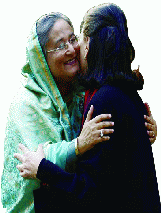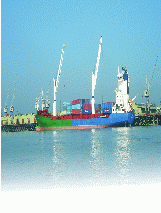Sheikh a Friendly Hand
Sheikh a Friendly Hand
A Christmas sermon reads, “There is an idea abroad among moral people that they should make their  neighbours good. One person I have to make good – myself. But my duty to my neighbour is much more nearly expressed by saying that I am to make him happy – if I may.” – Robert Luis Stevenson (1850 – 1894)
neighbours good. One person I have to make good – myself. But my duty to my neighbour is much more nearly expressed by saying that I am to make him happy – if I may.” – Robert Luis Stevenson (1850 – 1894)
It is rightly said that if our neighbour is facing a crisis, the impact of which will always be felt by us. It is a geographical fact that Bangladesh is our neighbour and a consequence of the partition of India that both countries suffered economic and social losses during the past few decades. However, India has emerged in a better condition than its neighbour from these past tribulations. Bangladesh, has not fared as well.
Though India brought freedom for Bangladesh, after the assassination of Sheikh Mujibur Rahman, the first Prime Minister of Bangladesh, the fundamentalists took over the reins of power and as a consequence of this, Indian terrorist groups were granted a safe haven and aid from the then Bangladesh Government.
This in turn resulted in a lot of pain and loss both in terms of lives and property in India as these terrorists ran amok and perpetuated numerous cross – border crimes. Things took a turn for the better with Sheikh Hasina Wajed being elected as the Prime Minister of Bangladesh on the 6th of January 2009. In stark contrast to the previous leaders of Bangladesh, Sheikh Hasina is pro – India and knows all too well that a friendly  relationship with India will only help Bangladesh to grow as Bangladesh is a land locked state with boundaries with India on three sides.
relationship with India will only help Bangladesh to grow as Bangladesh is a land locked state with boundaries with India on three sides.
As a first step, Sheikh Hasina, as a good neighbour declared that Bangladeshi territory would not be used by anti – Indian groups and that none of these groups would be given shelter there.
On the 4th of December 2009, Arbinda Rajkhowa, the Chairman of the post - scribed United Liberation Front of Asom (ULFA) along with his family members and other senior members of the organisation surrendered at the Dawki area of Meghalaya. This is perhaps due to the fact that they realised that Bangladesh no longer afforded them safe refuge. Caught between the mountain and the sea, they had no other option but to surrender to the Indian authorities. This is a direct result of this new move by the Awami League led by Sheikh Hasina which is presently in power in Bangladesh. This event further endeared Sheikh Hasina and her efforts to curb the terrorism that has plagued India ever since it attained its independence way back in 1947. This also reiterated the fact that Sheikh Hasina means business and is not all talk, a prevalent quality in most political leaders.
After this high profile surrender, Sheikh Hasina began 2010 with a visit to India in the first week of the year to receive the prestigious Indira Gandhi Prize for Peace which was instituted in 1986, two years after the assassination of Indira Gandhi.
Interestingly, Sheikh Hasina’s visit has brought about a new dimension between India and Bangladesh. It has bridged prior differences and promises to further mend old grievances between the two countries. The Chief Ministers of the Northeastern states of India were also invited for an interaction with the Bangladeshi Prime Minister. While Tarun Gogoi, the Chief Minister of Assam expressed his concern about the security issue of Assam, Dr. D. D. Lapang, the Chief Minister of Meghalaya called for the institution of a direct flight between Shillong and Dhaka to promote tourism besides education opportunities in Meghalaya for students from Bangladesh.
The other highlights of the visit include:
a. Mutual legal assistance in criminal matters.
b. Agreement on transfer of sentenced persons and a pact on combating international terrorism, organised crime and drug trafficking.
c. Power and infrastructure development.
d. Duty free import of eight million pieces of garments.
e. One time line of credit of 1 billion dollars, the highest so far India has given to any country.
However, in spite of all these developments, nothing was discussed about the sensitive issue of infiltration and nothing concrete was arrived at regarding an extradition treaty. An extradition treaty with Bangladesh is a very important step that must be taken in order to bring some top ULFA leaders like Anup Chetia to book for crimes in India as they are already serving sentences in Bangladeshi jails.
The discussions during Sheikh Hasina’s visit stressed on the issue of development. The re – vamping of the Akhaura – Agartala rail line has been proposed and if this goes through, it will reduce the distance between the two points and will further improve communication.
As stated earlier, India was partitioned in 1947. As a result of this, a great number of weekly haats (markets) near the present international border were closed which greatly hampered the rural economy. A decision has been taken whereby weekly haats of specific notified goods will be permitted in the border areas. Meghalaya is one among many states who are demanding the re – opening of these border haats.
For a long time now, Bangladesh has been denying India the use its Chittagong and Mongla ports. It has now changed its tune and has opened up these two ports for India to use. This is a major fillip to the tea industry of Assam which comprises over 100 tea gardens predominantly in the Barak Valley area of the state. These will gain a great deal from this as goods ferried through Chittagong will reduce transit costs in a major way.
Substantially, going a step ahead, Sheikh Hasina recently said, “In the present – day world, you can not live with your door closed. We will allow Nepal and Bhutan to use these two ports also.” The Prime Minister of India Dr. Manmohan Singh has also made promises and compromises, the most significant of which is that he assured Sheikh Hasina that India would not go ahead with the proposed Rs 6000 crore Tipaimukh Project in Manipur which is likely to cause harm to Bangladesh.
It may be noted here that the Tipaimukh Project is slated as one of the largest hydroelectric projects in Eastern India to date to be located 500 meters downstream of the confluence of the Tuivai and Barak Rivers in the District of Churacchander in the state of Manipur, near the Manipur - Mizoram border. The Project would have had a 6 X 250 MW power house and was slated to be completed in an estimated time of 12 years.
However, protest against the project was rife in both India and Bangladesh as protesters argued that the project did not take into consideration the effect on downstream areas. Serious protest campaigns were also initiated by environmentalists who argued that the project would result in the annihilation of large scale habitats resulting in the incalculable loss of both fauna and flora species. Environmental experts from both countries also say that building the dam could cause two rivers in Bangladesh downstream from the dam to dry up. In spite of all the protests, the Government of India had decided to go ahead with the project until this point of time. All this taken into consideration, it is quite a big compromise for India to shelve the Tipaimukh Project.
A good relationship between India and Bangladesh will be mutually beneficial. The imbalances in trade, commerce and industry between the two countries need to be improved. Once this is done, it will be the North East which reaps the majority of the benefits. Let us hope that with the joint celebration of the 150th birth anniversary of Rabindranath Nath Tagore by both the countries, this new found friendship will continue to improve with the passage of time.
Dr. K. K. Jhunjhunwala

